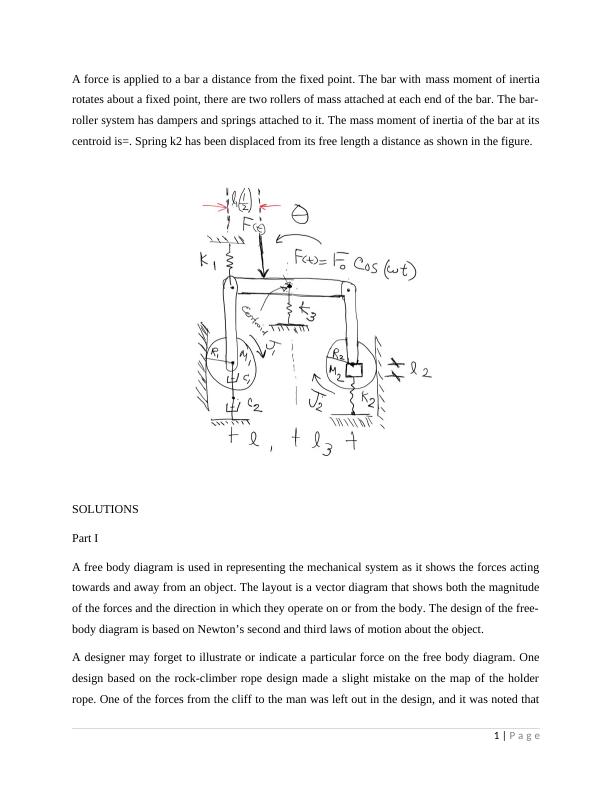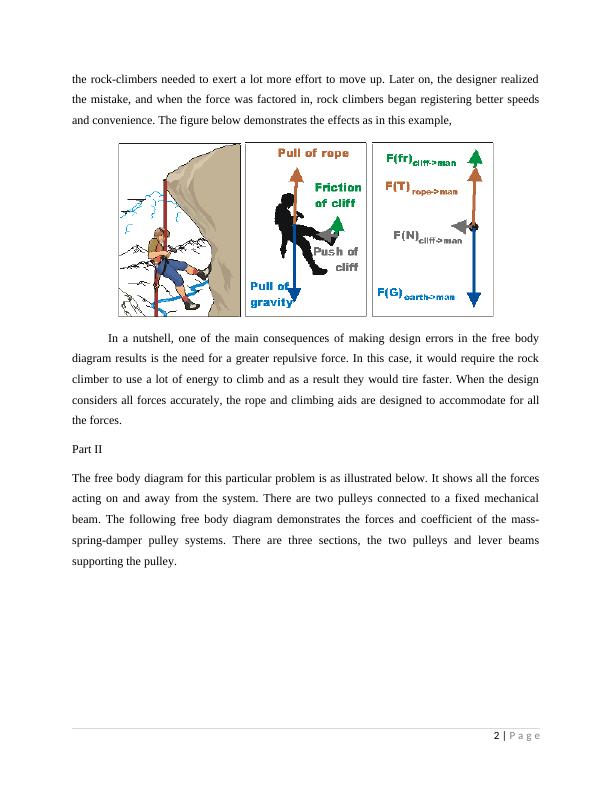The Bar-Roller System: Analysis of Free Body Diagram, Equivalent Mass, Spring, Damper, and Equation of Motion
Added on 2023-06-10
18 Pages3490 Words184 Views
[Year]
THE BAR-ROLLER SYSTEM
STUDENT NAME
STUDENT ID NUMBER
INSTITUTIONAL AFFILIATION
FACULTY OR DEPARTMENT
COURSE ID & NAME
DATE OF SUBMISSION
THE BAR-ROLLER SYSTEM
STUDENT NAME
STUDENT ID NUMBER
INSTITUTIONAL AFFILIATION
FACULTY OR DEPARTMENT
COURSE ID & NAME
DATE OF SUBMISSION

A force is applied to a bar a distance from the fixed point. The bar with mass moment of inertia
rotates about a fixed point, there are two rollers of mass attached at each end of the bar. The bar-
roller system has dampers and springs attached to it. The mass moment of inertia of the bar at its
centroid is=. Spring k2 has been displaced from its free length a distance as shown in the figure.
SOLUTIONS
Part I
A free body diagram is used in representing the mechanical system as it shows the forces acting
towards and away from an object. The layout is a vector diagram that shows both the magnitude
of the forces and the direction in which they operate on or from the body. The design of the free-
body diagram is based on Newton’s second and third laws of motion about the object.
A designer may forget to illustrate or indicate a particular force on the free body diagram. One
design based on the rock-climber rope design made a slight mistake on the map of the holder
rope. One of the forces from the cliff to the man was left out in the design, and it was noted that
1 | P a g e
rotates about a fixed point, there are two rollers of mass attached at each end of the bar. The bar-
roller system has dampers and springs attached to it. The mass moment of inertia of the bar at its
centroid is=. Spring k2 has been displaced from its free length a distance as shown in the figure.
SOLUTIONS
Part I
A free body diagram is used in representing the mechanical system as it shows the forces acting
towards and away from an object. The layout is a vector diagram that shows both the magnitude
of the forces and the direction in which they operate on or from the body. The design of the free-
body diagram is based on Newton’s second and third laws of motion about the object.
A designer may forget to illustrate or indicate a particular force on the free body diagram. One
design based on the rock-climber rope design made a slight mistake on the map of the holder
rope. One of the forces from the cliff to the man was left out in the design, and it was noted that
1 | P a g e

the rock-climbers needed to exert a lot more effort to move up. Later on, the designer realized
the mistake, and when the force was factored in, rock climbers began registering better speeds
and convenience. The figure below demonstrates the effects as in this example,
In a nutshell, one of the main consequences of making design errors in the free body
diagram results is the need for a greater repulsive force. In this case, it would require the rock
climber to use a lot of energy to climb and as a result they would tire faster. When the design
considers all forces accurately, the rope and climbing aids are designed to accommodate for all
the forces.
Part II
The free body diagram for this particular problem is as illustrated below. It shows all the forces
acting on and away from the system. There are two pulleys connected to a fixed mechanical
beam. The following free body diagram demonstrates the forces and coefficient of the mass-
spring-damper pulley systems. There are three sections, the two pulleys and lever beams
supporting the pulley.
2 | P a g e
the mistake, and when the force was factored in, rock climbers began registering better speeds
and convenience. The figure below demonstrates the effects as in this example,
In a nutshell, one of the main consequences of making design errors in the free body
diagram results is the need for a greater repulsive force. In this case, it would require the rock
climber to use a lot of energy to climb and as a result they would tire faster. When the design
considers all forces accurately, the rope and climbing aids are designed to accommodate for all
the forces.
Part II
The free body diagram for this particular problem is as illustrated below. It shows all the forces
acting on and away from the system. There are two pulleys connected to a fixed mechanical
beam. The following free body diagram demonstrates the forces and coefficient of the mass-
spring-damper pulley systems. There are three sections, the two pulleys and lever beams
supporting the pulley.
2 | P a g e

Part III
Equivalent mass stores the kinetic energy as it is supplied to it. The mass in a lumped system is
considered the inertia element. Newton’s second law is applied to determine the equivalent mass
in both translation and rotational motion.
Real Example,
Kinetic Energy system=Kinetic Energy Model
1
2 M ̇xcm
2+ 1
2 I cm ̇θ2= 1
2 M eff ̇xB
2
1
2 M ( L
2 ̇θ )2
+ 1
2 I cm ̇θ2= 1
2 M eff ( L ̇θ )2
3 | P a g e
Equivalent mass stores the kinetic energy as it is supplied to it. The mass in a lumped system is
considered the inertia element. Newton’s second law is applied to determine the equivalent mass
in both translation and rotational motion.
Real Example,
Kinetic Energy system=Kinetic Energy Model
1
2 M ̇xcm
2+ 1
2 I cm ̇θ2= 1
2 M eff ̇xB
2
1
2 M ( L
2 ̇θ )2
+ 1
2 I cm ̇θ2= 1
2 M eff ( L ̇θ )2
3 | P a g e

End of preview
Want to access all the pages? Upload your documents or become a member.
Related Documents
Mass Moment of Inertia: Calculation and Applicationlg...
|12
|1174
|107
Magnification Factor and DOF simulation- Projectlg...
|25
|3505
|357
